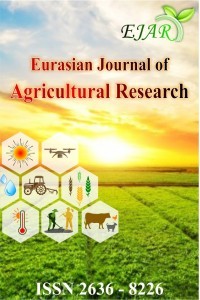Use of Treatment Water for Irrigation
Use of Treatment Water for Irrigation
In this research, the use of waste water produced after treatment for irrigation purposes was investigated. Clean water resources in our world are gradually decreasing and water scarcity is experienced in some countries. For this reason, people turned to domestic water obtained after treatment. In order to meet the water needs of plants, clean water resources are needed. The use of potable water instead of drinking water for this purpose provides a large amount of savings. In this sense, the quality of the water used is very important. Treatment waters must have certain criteria for use in agricultural irrigation. Criteria for wastewater from conventional activated sludge; AKM, BOD and total nitrogen value less than 1 mg / L, the COD value should be less than 2. Ammonium value should be maximum 0.1 mg / L, total phosphorus value should be 0.5 mg / L (Çevre ve Şehircilik Bakanlığı). It is desirable to infect plants with any harmful substances from outside. For this reason, continuous analysis of the water used should be controlled.
Keywords:
Environment, Wastewater Irrigation.,
___
- Aydın M.E., Aydın S., Bedük F., Tekinay A., 2015. Use of Wastewater in Irrigation: Persistent Organic Pollutants in Soil and Product. Journal of Uludag University Faculty of Engineering, 20(2).
- Bedbabis S., Trigui D., Ahmed C.B., Clodoveo M.L., Camposeo S., Vivaldi A.G., Rouina B.B., 2015. Long-terms effects of irrigation with treated municipal wastewater onsoil, yield and olive oil quality, Agricultural Water Management, 160: 14–21.
- Chen Y., Wang C., Wang Z., 2005. Residues and Source Identification of Persistent Organic Pollutants in Farmland Soils Irrigated by Effluents from Biological Treatment Plants. Environment International, 31, 778 – 783.
- Filibeli A., Yüksel N., 1994. Assessment of wastewater potential for agricultural irrigation water needs. Gökova Bay Environmental Problems and Environmental Management Symposium., 139–152
- Hussain I., Raschid L., Hanjra M.A., Marikar F., Van der Hoek W., 2002.International Water Management Institute. Wastewater use in agriculture: Review of impacts and Methodological Issues in Valuing Impacts, Colombo, Sri Lanka, Working Paper 37.
- Jouyban Z.,2012. The effects of salt stress on plant growth, Technical Journal of Engineering and Applied Sciences, 2(1), 7-10.
- Luprano M.L., De Sanctis M., Del Moro G., Di Iaconi C., Lopez A., Levantesi C., 2016. Antibiotic resistance genes fate and removal by a technological treatment solution for water reuse in agriculture. Science of the Total Environment, 571, 809-818.
- Ministry of Environment and Forestry,. Communique on Technical Procedures for Wastewater Treatment Plants, Leaving Water Quality for Different Treatment Systems http://www.resmigazete.gov.tr/eskiler/2010/03/20100320-7.htm Date of Access: 2.07.2019
- Özbay İ., Kavaklı M., 2008. Treated Wastewater in Turkey and in other countries Recycling Practices Investigation. Environmental Problems Symposium, Kocaeli.
- Pedrero F., Kalavrouziotis I., Alarcon J.J., Koukoulakis P., Asano T., 2010. Use of treated municipal wastewater in irrigated agriculture. Review of some practices in Spain and Greece. Agricultural Water Management, 97: 1233-1241.
- Pesco, M.B., 1992. Wastewater Treatment and Use in Agriculture. Irrigation and Drainage Paper, No. 47, FAO, Rome. 125 p
- Van Oort F., Thiry M., Foy E., Fujisaki K., Delarue G., Dairon R., Jongmans T., 2017. Impacts of one century of wastewater discharge on soil transformation through ferrolysis and related metal pollutant distributions. Science of the Total Environment, 590-591, 1-13.
- ISSN: 2636-8226
- Yayın Aralığı: Yılda 2 Sayı
- Başlangıç: 2017
- Yayıncı: Muhammed Cüneyt BAĞDATLI
Sayıdaki Diğer Makaleler
Feed Evaluation Methods: Performance, Economy and Environment
Oyinkansola OLUBUNMİ OLOWU, Sema YAMAN
Use of Herbal Food Additives in Fisheries
Muhammad Zeeshan AKRAM, Sema YAMAN FIRINCIOĞLU
Use of Treatment Water for Irrigation
An Important Cycle in Hydrological Cycle: Rainwater Harvesting
